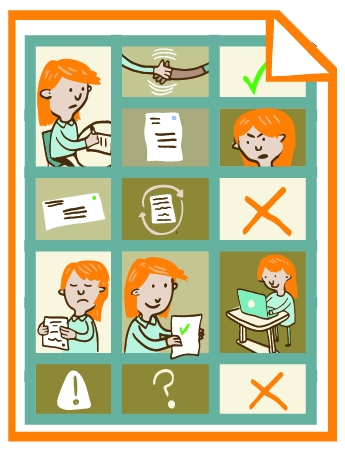There’s this thing I like to do in the creative writing classes I teach. I show my students my submissions spreadsheet.
It’s a bit of a bummer, I know. My students tend to come into class believing in the sorcery of fiction. And so they should. Writing is magic! But like all magic, it’s mysterious only on the outside. Inside it’s all hidden compartments, secret handshakes, trial-and-error, and dogged hard work. I am no wizard, but when I show my students my spreadsheet I can’t help but think of The Wizard of Oz. ‘Pay no attention to that man behind the curtain!’

‘That acceptance lit a fire under my butt.’ Illustration by Josh Quick.
My spreadsheet is six columns wide and 280 rows long—one for just about every story or article I’ve submitted. The columns are arranged by journal, submission date, title, journal editor, submission status, and miscellaneous notes.
The ‘Submission Title’ column is the most informative. I’ve sent out plenty of stories prematurely, when they were still undercooked. When the title of a story appears six times in a row beside six rejections, I can tell it’s time to think about revising it. The ‘Notes’ column is useful in a different way. These days I use it mostly to track submission fees so I can write them off on my taxes.
The ‘Journal’ column is depressing. After submitting five or ten times to the same journal you can’t help but feel they have something against you personally. (What did I ever do to you, New England Review?) But by far the most dispiriting column is ‘Submission Status.’ From top to bottom, except for where the odd cell reads ‘nice rejection!’ or ‘asked for more work!’—or, less frequently, ‘accepted!’— the vast majority repeat ‘declined,’ ‘declined,’ ‘declined.’ Of my 280 submissions so far, 26 have ended in publication.
Looking at that ratio one might gather that publishing is just a numbers game. And anyone in the business of writing will tell you the odds are about 1 in 100. But my submissions spreadsheet tells a more nuanced story.
The very first entry is dated December 29, 2008, but that one was added retroactively. In 2008 I was still living with my parents. I was anxious about the future. I was worried my half-baked idea of becoming a writer was utterly delusional. Every day I’d come home from work, pour myself an unhealthy amount of wine, and work on the stories in my MFA application portfolio. (One was about a depressed girl living with her mom in Brooklyn. Write what you know!) On 12/29/08, right after mailing out my applications to grad school, I impulsively submitted one of the stories therein to a Narrative Magazine contest. Unbelievably, it got an honorable mention. I’d carry that honorable mention with me like a talisman to Indiana University the following year.
In my MFA cohort, I connected with a kind, ambitious poet. Though we were just first years, he’d already started sending out his work. He showed me the spreadsheet where he tracked his submissions. I was deeply impressed. It was so thoroughly organized, so pristinely anal—the perfect obsession to keep my anxieties at bay. I started a spreadsheet of my own. For the sake of morale, in the very first row I typed in my small success at Narrative.
Meanwhile I kept working. I kept writing. I kept learning. I learned how much I didn’t know. For instance: plot. What the hell was plot? I wrote a series of short surreal vignettes, most of which had no plot at all. Still, I kept submitting—just a little, here and there. In May 2010, Hobart took one of those vignettes—the only one with anything like a plot. It was my very first publication, and it is still my most instructive.
That acceptance lit a fire under my butt. I doubled down on my submissions. In 2011, I sent stories out to 50 journals—and got 50 rejections. That was deeply discouraging. I felt as if I were sending my beloved work out into a heartless void. But then, in 2012, I sent out 30 submissions and got only 27 rejections. Three stories placed! So exciting! So gratifying! I began to allow for the possibility that it might not have been entirely delusional to try to be a writer. In 2013 I sent out 37 submissions and placed three more pieces. In 2014 I sent out 33 and placed two. I placed four in 2015, and five in 2016. This year I have received eight acceptances to date.
I’d like to think that my slowly increasing success rate has everything to do with the quality of my work. But work doesn’t improve in a vacuum. The submissions process itself has played a role in my creative growth. Over nine years of rejections I’ve gotten a better sense of what doesn’t work. A few gracious editors have offered smart critiques. But even rejections that haven’t come with comments have been instructive. While I still have stories I love, but haven’t found a home for, I have others that have been rejected so many times that I’ve either abandoned them at last, or drastically revised them. The submissions process is survival of the fittest for the written word.
Meanwhile, as my work has gotten stronger, so have my relationships with editors and other writers. Perhaps the most valuable result of all my 280 submissions, then, is not my 26 publications. Perhaps it is the conversation that’s grown and proliferated around my process.
Recently an editor who’d published a short story of mine years ago got in touch and asked me to write a post for her journal’s blog. As I considered what to write, I felt intensely fortunate. Not just that I got to write for her again—though that was a blast—but because I realized the submissions process no longer feels like ejecting my work into a heartless void. It feels like a conversation with real people—great people—people who love words. That’s a conversation I can bring back into the classroom. It’s a conversation that doesn’t just improve my work, but also enriches the literary community.
